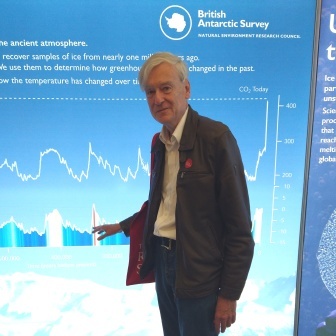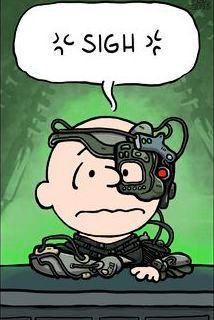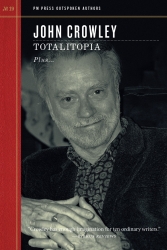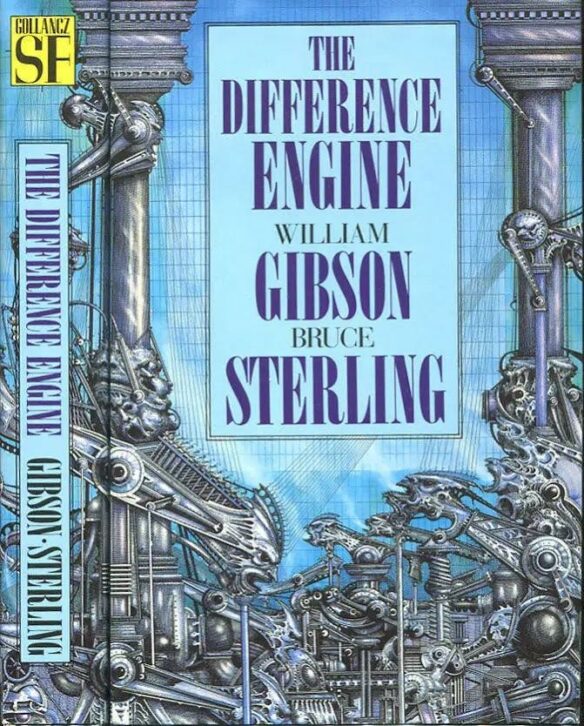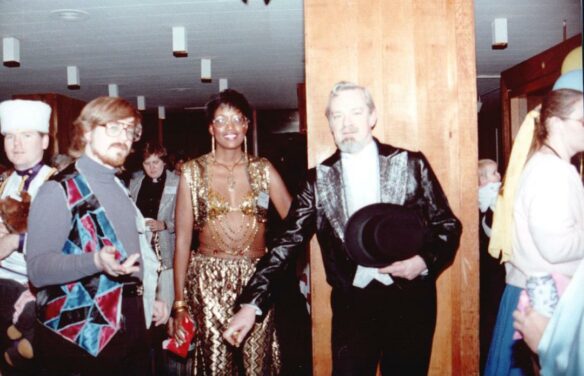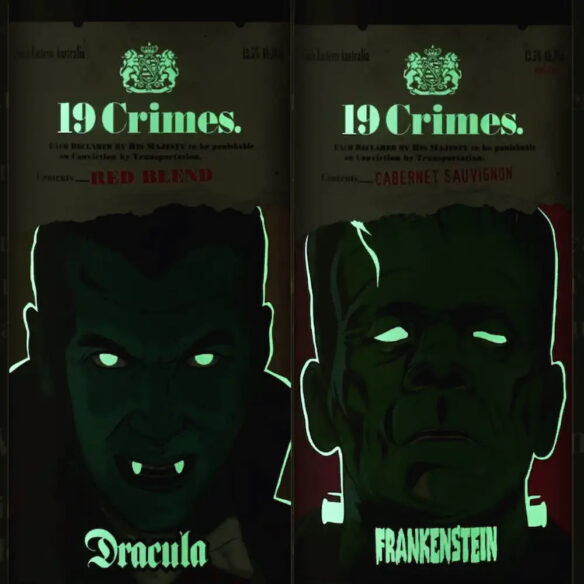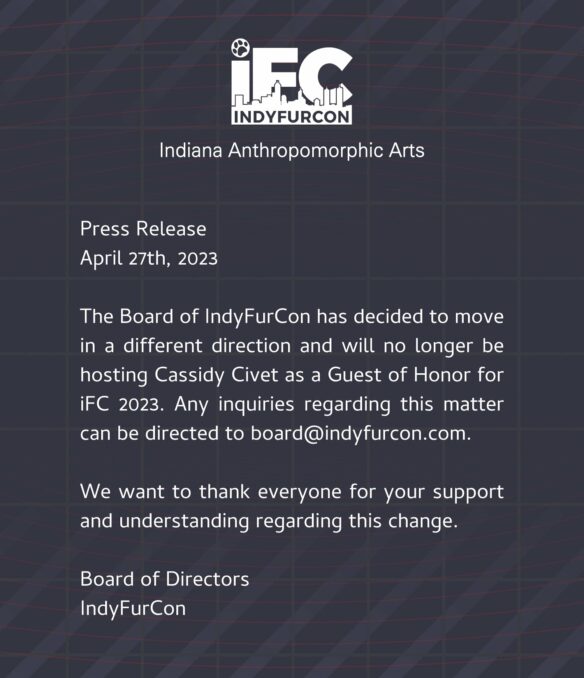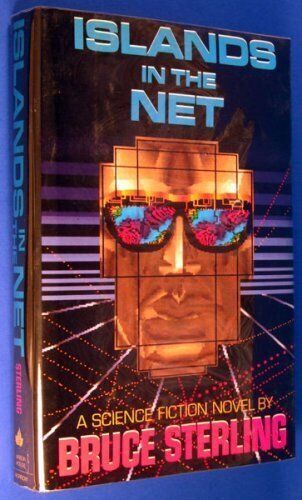(1) THE VERSIFICATORE. Bruce Sterling offers the creation of a working Star Trek-style communicator as one example of “How to Rebuild an Imaginary Future (2025)” in the Medium transcript of an extemporaneous speech he gave at SXSW 2025 on March 12. Then he goes into full detail about a comparable project he’s involved with in Italy. (Let me emphasize this is not an April Fools post.)
Fifteen years ago, here at South By Southwest, I was on a panel where the term “design fiction” was made public. Before Julian Bleecker invented and deployed that term, there were many things going on that resembled “design fiction.” But nobody knew “how to do design fiction.” The ideas and approaches were diffuse, they weren’t crystallised.
This current speech is taking place in another decade, in a era where “design fiction” has been normalized, and it’s practiced widely. “Design Fiction” is established, and is part of the worlds of design and futurism. This speech, “How to Rebuild an Imaginary Future,” is also about futurism, design, and design-fiction “diegetic prototypes.”…
…I am the art director of a technology art festival in Turin, Italy, which is called “Share Festival.” In our researches, we found a historical design-fiction that we want and need to rebuild for artistic and cultural reasons. And we are rebuilding it. It’s an artifact, an imaginary machine, from a science fiction story written 65 years ago by a science fiction writer in Turin: Primo Levi.
Primo Levi’s imaginary “Versificatore” is as old as a Star Trek Communicator. It is a cybernetic, desktop, mass-manufactured business machine that can write Italian poetry. The Versificatore works with prompts, very much like ChatGPT. So, Primo Levi’s historic “Versificatore” is a prophetic vision of Large Language Model Artificial Intelligence.

The Versificatore first appeared, in May 1960, as a character in a short drama piece that Levi published in a newspaper. Years later, that story was gathered into a collection of other futuristic gadget stories that Primo Levi also wrote, as part of a series of Levi’s science fiction satires and comedies.
In 1971, the Versificatore became one episode of Italian TV series derived from the Levi stories.
In these screenshots from the TV show, we can see an Italian poet, and a technology salesman, and a secretary interacting with their brand-new desktop poetry machine. The machine is a creative writer and is the center of the action in the drama. The humans react to this intelligent machine with varying attitudes of enthusiasm, amazement, commercial interest, dread, alarm and so on.
It’s quite amazing how well Levi understood the future human reactions to a novelty like an AI that can write human language. You can watch that show on YouTube right now, it’s quite engaging and funny. Of course it’s all in Italian, but who cares? As you watch the show, you can get Google’s Artificial Intelligence to translate the TV show from speech to subtitled text in real-time. It turns out, sixty year later, that Primo Levi was quite right about the prospect of machines with an astonishing command of human language. They’re very much here, and wreaking predictable havoc.
So, at Share Festival, thanks to a good friend, Riccardo Luna from “Wired Italia,” we became aware of Levi’s diegetic prophesy of modern AI. Since Primo Levi was from Turin, and we’re a festival from Turin, we immediately decided that we had to rebuild a Levi Versificatore and show that device to our public. We understand that the Versificatore has historic, artistic, cinematic, computational and literary significance. It should be a public source of civic pride.
In other words, we are motivated to rebuild an imaginary future. This is not a merely hypothetical project. It’s an actual artistic production project, and even a patriotic crusade. It’s a practical matter for us, where we have to raise funds, and find designers and crafts people, and find a venue for the display of our new artifact, and so on….
…Let’s admit it: it’s a rather unusual thing to re-make an imaginary Italian Artificial Intelligence from the 1960s that works in public and speaks Italian poetry. But in this speech, I want to put that work into a larger context. It’s just one practical sample of a broader creative practice, which might be described as: deliberately turning culturally significant imaginary things into functional real-life things.
We are using modern capabilities to make things work, when it was once merely imagined that these things might somehow someday work.
This Versificatore project is a physical demonstration of the impressive prescience of a world-famous Turinese writer. Primo Levi made up some other different gadgets in his stories, but with this one, he hit the predictive jackpot.
We have means, motive and opportunity to rebuild this important object, for our public, which is the Turinese public, and for our client, who is MUFANT, the science fiction and fantasy museum in Turin. Turin has a museum of “fantascienza,” so naturally they’re interested in Turinese science fiction museum exhibits. Like this one.
So, with that given, what is the proper way to do this? We are confident that we can build a replica, but what are the best practices here? Who else is doing anything like this? Where can we get some help and good advice? How do we know if we’ve done a good job? What are we trying to prove with this project?…
(2) CHINA MIÉVILLE Q&A. [Item by Tom Becker.] Capitalist billionaires are changing the world’s political and economic systems to serve their visions of the future that are straight out of science fiction. China Miéville, who knows politics and science fiction very well, punctures that balloon in an interview with TechCrunch: “China Miéville says we shouldn’t blame science fiction for its bad readers”.
Even though some science-fiction writers do think in terms of their writing being either a utopian blueprint or a dystopian warning, I don’t think that’s what science fiction ever is. It’s always about now. It’s always a reflection. It’s a kind of fever dream, and it’s always about its own sociological context. It’s always an expression of the anxieties of the now. So there’s a category error in treating it as if it is “about the future.”
The full interview is well worth reading, because Miéville is always interesting, and he has much to say about the fantasy traditions that inspired him, and the science fiction that he loves, and the value of literature that is diverse and contradictory and not a simplistic blueprint.
(3) IS PRATCHETT MORE BASED THAN TOLKIEN? “Discworld Rules” claims Venkatesh Rao at Contraptions.
The Lord of the Rings is a great story, but I have to say, I’ve never understood the strange hold it seems to have on the imagination of a particular breed of technologists.
As a story it’s great. It is pure fantasy of course (in the Chiang’s Law sense of being about special people rather than strange rules), full of Chosen Ones doing Great Man (or Great Hobbit) things. As an extended allegory for society and technology it absolutely sucks and is also ludicrously wrong-headed. Humorless Chosen people presiding grimly over a world in terminal decline, fighting Dark Lords, playing out decline-and-fall scripts to which there is no alternative, no Plan B.
This is no way for a high-agency technological species to live, and thankfully it doesn’t have to be.
I mean, I get why politicians and economists might identify with the story. They enjoy little to no direct technological agency, harbor ridiculous Chosen One conceits, and operate in domains — political narratives and the dismal pseudoscience of economics — that are natural intellectual monopolies or oligopolies. Domains that allow fantasies to be memed into existence (the technical term is hyperstitional theory-fictions) for a while before they come crashing down to earth in flames, demonstrating yet again that no, you do not in fact get to create your own reality; that “reality is that which, when you stop believing in it, does not go away.”
There is a contrarian reading of The Lord of the Rings that argues that Sauron and Mordor are in fact the good guys, and represent technological progress, etc. But this is throwing good
moneynarrativium after bad. Flipping the valence of a Chosen One story doesn’t make it any better. It’s still a Chosen One story with reversed roles.No, you have to tell different sorts of stories altogether.
Such stories have, in fact, been told. They are Terry Pratchett’s Discworld stories. This post is an extended argument that as a lens for thinking about the world, The Lord of the Rings, is a work that you should “not set aside lightly, but throw across the room with great force,” and that in place of Middle Earth, you should install Terry Pratchett’s Discworld….
… If you’re an actual, serious technologist, Discworld is where you should look for clues about how the world works, how it evolves in response to technological forces, and how humans should engage with those forces. It is catnip for actual technological curiosity, as opposed to validation of incuriously instrumental approaches to technology….
(4) FEARLESS MONSTER FANS. Peter Bebergal will deliver a Zoom lecture, “Monster World”, about “How pop culture monsters mythologised our worries about sexuality, nuclear war, race and the other” on April 14. This Last Tuesday Society digital event begins at 8:00 p.m. – British time, apparently. Tickets are £6 – £10 & By Donation. Ticket buys also will be sent a recording valid for two weeks the next day.
Monster Worlds
In the 1970s, the sometimes-garish world of monster-movie pop culture was a comfort, an external expression of grotesquery and strangeness that the culture was feeling inside but had no name for. Rather than making us more afraid, monsters mythologized our own abstract worries about sexuality, nuclear war, race and the other, as well as personifying our collective sense of being untethered from mystery and enchantment. The talk will track the changing face of monsters as mythic and literary creatures as our culture’s own lingering unease began to morph, moving from the shadowed myths of the past into the daytime horrors of serial killers and gore and argue that we need monsters again to learn how to reimagine what frightens us in a way that remythologizes our anxieties and will offer a path for a re-enchanting our imaginations using monsters as a guide, looking at current examples in film, television, and comics.
(5) CRAWFORD AWARD JUDGES SOLICIT SUBMISSIONS FOR 2025. The William L. Crawford Award, given by the International Association of the Fantastic in the Arts (IAFA), recognizes an outstanding writer whose first fantasy book was published during the previous calendar year. The judges are currently soliciting books published in 2025 for the award to be given at the International Conference of the Fantastic in the Arts in 2026.
Publishers are asked to submit qualifying ebooks in PDF and ePub formats here.
What works qualify
This is an award for an author’s first work of fantasy in book form. It is not a first novel award; an author may have a long bibliography and still qualify for their first work of fantasy. “Book” is defined broadly, and includes novels, novellas, poetry collections, short fiction, graphic novels, works in translation, or other work at the discretion of the judges.
The Award Administrator is Kelly Robson. This year’s judges are Brian Attebery, Joyce Chng, Eddie Clark, Joy Sanchez-Taylor, and Bodhisattva Chattopadhyay.
Brian Attebery is an American writer and emeritus professor of English and philosophy at Idaho State University. He is known for his studies of fantasy literature, including The Fantasy Tradition in American Literature: From Irving to Le Guin and Strategies of Fantasy which won the Mythopoeic Award
Joyce Chng lives in Singapore. Their speculative fiction has appeared in The Apex Book of World SF II, We See A Different Frontier, Cranky Ladies of History, and Accessing The Future. Joyce also co-edited THE SEA IS OURS: Tales of Steampunk Southeast Asia with Jaymee Goh. Their novels span across wolf clans (Starfang: Rise of the Clan), vineyards (Water into Wine) and swordmaking forges (Fire Heart) respectively. Joyce wrangles article editing at Strange Horizons and is diversity coordinator for IGDN (Independent Game Designer Network).
Eddie Clark is an academic and SFF fan from Wellington, New Zealand. He has been peering into the obscure corners of SFF for thirty years, recently with a particular focus on queer fantasy.
Dr. Joy Sanchez-Taylor is a Professor of English at LaGuardia Community College whose research interest is science fiction and fantasy literature by authors of color. Her first book Diverse Futures: Science Fiction and Writers of Color (2021) examines the contributions of late twentieth and twenty-first century U.S. and Canadian science fiction authors of color to the genre. Her newest book is titled Dispelling Fantasies: Authors of Color Reimagine a Genre (forthcoming July 2025).
Bodhisattva Chattopadhyay is Associate Professor in Global Culture Studies at the University of Oslo. He is the leader of CoFUTURES, an international research group on contemporary futurisms headquartered in Oslo. He is a World Fantasy Award-winning editor, translator, writer, and critic of speculative fiction, and the producer of Kalpavigyan: A Speculative Journey, the first documentary film on Indian science fiction.
(6) MEMORY LANE.
[Written by Cat Eldridge.]
Ruthven Todd’s Space Cat series
The Muppet Show has a segment called “Pigs in Space.” Well, this is the Social Justice Credential counterpart, “Cats in Space”, with a dollop of ever-so-cute kittens added in, which appeared long before Heinlein’s Pixel came into being as they were published between 1952 and 1958.
This was definitely a departure for the author Ruthven Todd who is known primarily for his poetry, scholarly work on William Blake studies, and as R. T. Campbell for writing mysteries.
It’s a children’s books series involving Flyball, a cat who, yes, lives in space. And like all cats wears a space suit. These are not your ordinary felines by any means.
The books, which are all illustrated by Paul Galdone, are Space Cat, Space Cat Visits Venus, Space Cat Meets Mars and Space Cat and the Kittens. Without giving anything away, let me just say that there will be a lot of cats, not a few kittens and considerable comical situations as the series goes on.
If you don’t mind a lot of SPOILERS, James Davis Nicoll has a rather funny look at them over at Reactor.
They are available in both hardcover and from the usual suspects.

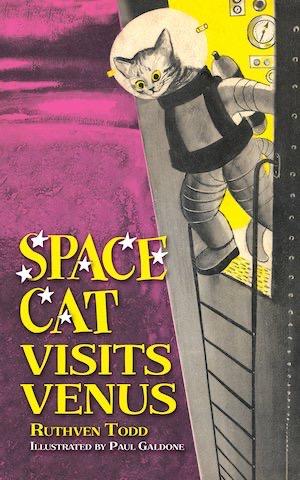


(7) COMICS SECTION.
- Brevity looks close and finds a digital pun.
- Brewster Rockit enters silent mode.
- Dinosaur Comics admires Shakespeare’s rule-breaking.
- Speckticles discovers the plot.
(8) STARLINER DEBRIEFING. Ars Technica spoke to the astronauts and learned “Starliner’s flight to the space station was far wilder than most of us thought”.
As it flew up toward the International Space Station last summer, the Starliner spacecraft lost four thrusters. A NASA astronaut, Butch Wilmore, had to take manual control of the vehicle. But as Starliner’s thrusters failed, Wilmore lost the ability to move the spacecraft in the direction he wanted to go.
He and his fellow astronaut, Suni Williams, knew where they wanted to go. Starliner had flown to within a stone’s throw of the space station, a safe harbor, if only they could reach it. But already, the failure of so many thrusters violated the mission’s flight rules. In such an instance, they were supposed to turn around and come back to Earth. Approaching the station was deemed too risky for Wilmore and Williams, aboard Starliner, as well as for the astronauts on the $100 billion space station.
But what if it was not safe to come home, either?
“I don’t know that we can come back to Earth at that point,” Wilmore said in an interview. “I don’t know if we can. And matter of fact, I’m thinking we probably can’t.”
Starliner astronauts meet with the media
On Monday, for the first time since they returned to Earth on a Crew Dragon vehicle two weeks ago, Wilmore and Williams participated in a news conference at Johnson Space Center in Houston. Afterward, they spent hours conducting short, 10-minute interviews with reporters from around the world, describing their mission. I spoke with both of them….
We cut to where two thrusters have just failed as the Starliner arrives at the ISS.
… Wilmore: “Thankfully, these folks are heroes. And please print this. What do heroes look like? Well, heroes put their tank on and they run into a fiery building and pull people out of it. That’s a hero. Heroes also sit in their cubicle for decades studying their systems, and knowing their systems front and back. And when there is no time to assess a situation and go and talk to people and ask, ‘What do you think?’ they know their system so well they come up with a plan on the fly. That is a hero. And there are several of them in Mission Control.”
From the outside, as Starliner approached the space station last June, we knew little of this. By following NASA’s webcast of the docking, it was clear there were some thruster issues and that Wilmore had to take manual control. But we did not know that in the final minutes before docking, NASA waived the flight rules about loss of thrusters. According to Wilmore and Williams, the drama was only beginning at this point….
(9) TAKING EXTRA TIME TO SPIN THIS WEB. “Spider-Man: Beyond the Spider-Verse’ Release Date and First Look” at Variety.
“Spider-Man: Beyond the Spider-Verse,” the third entry in Sony’s animated web-slinging trilogy, will swing into theaters… in a few years. It’ll be released on June 4, 2027.
“We know how important this franchise is to so many people around us. We just could not run it back,” the filmmaking team of producer Phil Lord and co-directors Bob Persichetti and Justin K. Thompson said at CinemaCon, the movie theater trade show that’s currently unfolding in Las Vegas. “So, we decided we needed to take the time to make sure we got it just right.”…
… On stage at CinemaCon, Lord teases that Miles begins the threequel as a fugitive on the run from every other spider in the multiverse… and hinted that “Gwen and his other friends may or may not be enough to help him save the family that’s been the leading part of the entire system.”…
(10) JUSTWATCH TOP 10S. The most-viewed streaming sff movies and TV of March 2025 have been ranked by JustWatch.

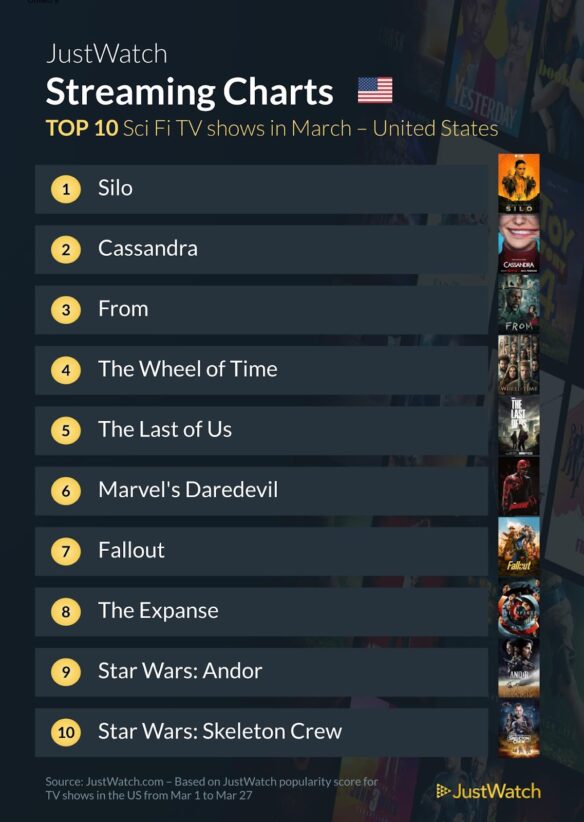
[Thanks to Andrew Porter, John King Tarpinian, Chris Barkley, Tom Becker, Cat Eldridge, SF Concatenation’s Jonathan Cowie, Mark Roth-Whitworth, Steven French, Kathy Sullivan, Teddy Harvia, and Mike Kennedy for some of these stories. Title credit belongs to File 770 contributing editor of the day Peer.]
















